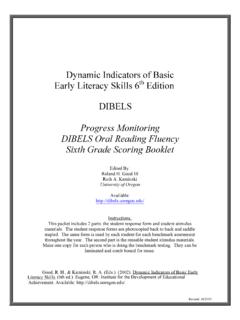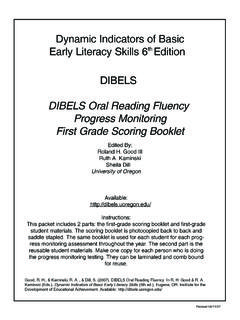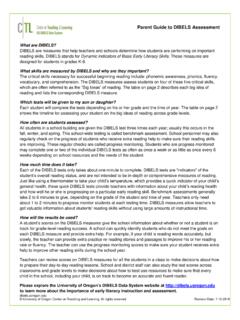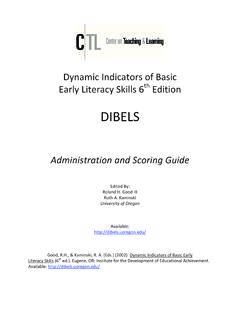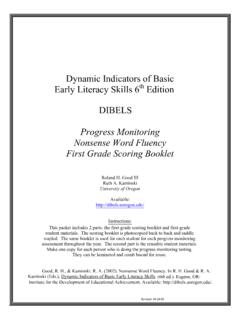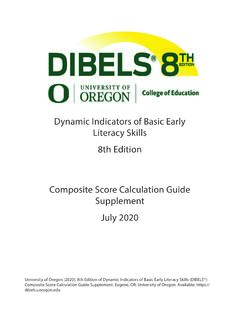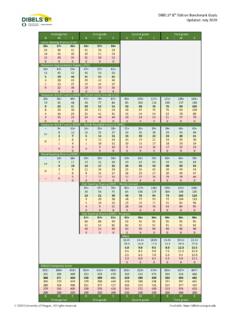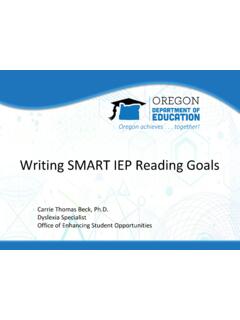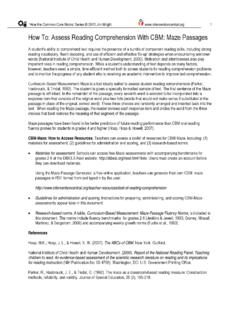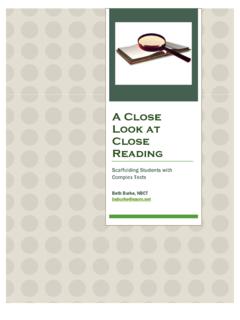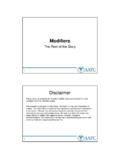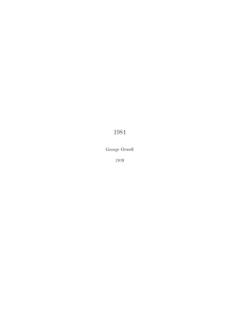Transcription of Dynamic Indicators of Basic Early Literacy Skills th Edition
1 Dynamic Indicators of Basic Early Literacy Skills 8th Edition Administration and Scoring Guide University of Oregon (2020). 8th Edition of Dynamic Indicators of Basic Early Literacy Skills (DIBELS ): Administration and Scoring Guide. Eugene, OR: University of Oregon. Available: Contributing Authors Gina Biancarosa, ED. D. Associate Professor and Ann Swindells Chair in Education Department of Educational Methodology, Policy, and Leadership College of Education, University of Oregon Patrick C. Kennedy, Research Associate and Director of Data Management and Analysis Group Center on Teaching & Learning College of Education, University of Oregon Sunhi Park Graduate Research Assistant Fellow Center on Teaching & Learning College of Education, University of Oregon Janet Otterstedt, MS.
2 Research Assistant and Project Coordinator Center on Teaching & Learning College of Education, University of Oregon Contributing Editors Maureen Warman, MS. Senior Research Assistant I and DIBELS Data System Manager Center on Teaching & Learning College of Education, University of Oregon David Larsen, MA. Senior Research Assistant II and DIBELS Data System Customer Support Manager Center on Teaching & Learning College of Education, University of Oregon University of Oregon would also like to acknowledge and thank our partner Amplify Education for their work on copy editing and formatting. Table of Contents Chapter 1: Introduction to DIBELS 8th DIBELS 6. Dimensions of reading Assessed by DIBELS 7. Description of DIBELS 8.
3 Appropriate Uses of DIBELS Rationale for and Innovations in DIBELS Development of DIBELS 23. Phonemes, Phones, and Scoring PSF and 38. Chapter 2: Administration Instructions and Scoring 42. DIBELS 8th Edition General 42. Letter Naming Fluency (LNF).. 53. Phonemic Segmentation Fluency (PSF).. 57. Nonsense Word Fluency (NWF)..64. Word reading Fluency (WRF).. 72. Oral reading Fluency (ORF).. 75. Chapter 3: Interpreting DIBELS 8th Edition DIBELS 8 Test Scores and their 87. DIBELS 8th Edition and Dyslexia Cautions in Interpreting DIBELS 8 92. Chapter 4: Progress Monitoring with DIBELS 8th Edition .. 94. Choosing a Subtest for Progress Monitoring ..94. Frequency of Progress 95. Determining Response to Off-grade Progress 97.
4 99. Appendix A: ORF Passage Appendix B: Maze Passage 114. Appendix C: DIBELS 8th Edition Pronunciation 118. Appendix D: Administration and Scoring Fidelity Appendix E: Composite Score Calculation Chapter 1: Introduction to DIBELS 8th Edition This manual is a compendium of information regarding DIBELS 8th Edition . It details the nature and purpose of DIBELS 8, how DIBELS 8 differs from previous editions of DIBELS, how to administer and score DIBELS 8 subtests, and how to use DIBELS 8 data to inform instructional decision-making. It also provides appendices for passage statistics, fidelity of implementation checklists, and composite scores. This manual begins with an overview of the history of the DIBELS assessment system.
5 DIBELS History The Dynamic Indicators of Basic Early Literacy Skills (DIBELS) consists of a set of measures for assessing reading Skills . DIBELS began as a series of short tests that assessed Early childhood Literacy in kindergarten and first grade (Meyer, 2000). Over the years, DIBELS. has gone through several editions, expanding the range of Skills assessed and grades in which it can be used. DIBELS is now in its 8th Edition , which offers reading measures for Grades K-8. DIBELS began as Dynamic Indicators of Basic Skills (DIBS; Shinn, 1989, 1998). Inspired by Deno's (1986) definition of curriculum-based measurement (CBM), DIBS, and DIBELS after it, was an attempt to ground classroom assessment practices and decision making in measurement science.
6 With the support of a federal grant, the first DIBELS. measures intended for use in the elementary grades ( , kindergarten and first grade) were developed as part of Dr. Ruth Kaminski's doctoral thesis in 1992 at the University of Oregon, where Dr. Roland Good served as her advisor. The measures were Letter Naming Fluency, Picture Naming Fluency, and Phonemic Segmentation Fluency. In the years since, the evolution of DIBELS measures and their interpretation has involved a number of University of Oregon faculty in addition to Dr. Good and Dr. Kaminski, including, but not limited to, Dr. Edward Kame'enui, Dr. Mark Shinn, and Dr. Deborah Simmons. In addition, numerous University of Oregon graduate students have contributed to the rich history of DIBELS.
7 Research and development, including Dr. Sylvia Barnes Smith, Dr. Rebecca Briggs, Dr. Kelli Cummings, Dr. Deborah Laimon, and Dr. Kelly Powell-Smith, among others. 6 | DIBELS 8th Edition - Chapter 1: Introduction Administration and Scoring Guide 2020 University of Oregon. All rights reserved. Updated editions of DIBELS have been released every several years beginning in 1996. Before DIBELS 8th Edition , the last update (DIBELS Next) was in 2010 and before that in 2002 (DIBELS 6th Edition ). Over the years, subtests have come ( , Nonsense Word reading Fluency, Oral reading Fluency) and gone ( , Picture Naming Fluency, Initial Sound Fluency). DIBELS 8th Edition continues the legacy of development and research that has been ongoing at the University of Oregon since the late 1980s.
8 It introduces several changes, including new features such as measures spanning kindergarten through eighth grade, a new DIBELS. measure (Word reading Fluency), and modern measurement approaches to scoring, as well as the retirement of two existing measures (First Sound Fluency and Retell Fluency). Dimensions of reading Assessed by DIBELS 8. DIBELS 8th Edition offers six subtests designed to assess component Skills involved in reading : Letter Naming Fluency (LNF), Phonemic Segmentation Fluency (PSF), Nonsense Word Fluency (NWF), Word reading Fluency (WRF), Oral reading Fluency (ORF), and Maze. These subtests are aligned to four of the five Big Ideas in reading identified by the National reading Panel (National Institute of Child Health and Human Development, 2000), including phonological awareness, phonics (or the alphabetic principle), fluency, and comprehension (Riedel, 2007; see Table ).
9 In many ways the DIBELS subtests represent not only the constructs in the National reading Panel Report (NICHD, 2000), but also a developmental continuum. As a result, the subtests included change across grades in a manner that parallels student development and instructional foci (Adams, 1990; Chall, 1996; Ehri, 2005; Paris &. Hamilton, 2009). Administration and Scoring Guide Chapter 1: Introduction - DIBELS 8th Edition | 7. 2020 University of Oregon. All rights reserved. Table The Big Ideas in reading and DIBELS 8 Subtests Big Idea LNF PSF NWF WRF ORF Maze Phonemic awareness X. Alphabetic principle X X X. Accuracy and fluency with text X X X. Vocabulary Comprehension X X. Some DIBELS 8 subtests are also aligned to subskills of reading that are associated with risk for dyslexia and other word reading disabilities.
10 The International Dyslexia Association (IDA) recommends universal screening of students in kindergarten through second grade (IDA, 2019). Consistent with IDA recommendations, DIBELS 8 offers LNF, PSF, and NWF subtests as dyslexia screening measures of rapid naming (or processing speed), phonemic awareness, and letter-sound correspondence for use in kindergarten and first grade. Also consistent with IDA recommendations, DIBELS 8 offers real and nonsense word measures (NWF, WRF, and ORF) as dyslexia screening measures. Description of DIBELS 8. DIBELS 8th Edition takes a curriculum-based measurement (CBM) approach to assessing reading . It is intended for assessing reading Skills from the beginning of kindergarten through the end of eighth grade.
